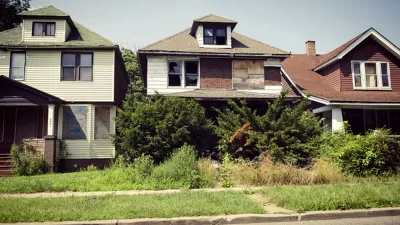Every city with neighborhoods in decline and a lack of demand for new investment is faced with the challenge of how to address blight. Each city's challenges are unique, but many are finding new and effective strategies to end the spread of blight.
Emily Badger reports on novel techniques in cities around the country to combat blight—especially the creeping kind of blight that starts small and picks up momentum as it consumes whole blocks and neighborhoods.
Badger introduces a few examples of the blight reduction work from Detroit, Philadelphia, Chicago, and Jacksonville before providing in-depth analysis of work by the Pennsylvania Horticultural Society to clean newly empty lots and maintain exiting ones. "Today, it regularly maintains about 6,500 greened vacant lots, April through October (the program has also created a landscaping industry in the city from scratch). Another 2,100 lots receive care once a month from paid neighbors. Since the start of the program, about 700 lots have gone on to be redeveloped."
All that hard work in Philadelphia has produced a wealth of academic research, listed by Badger, on the benefits of blight reduction programs.
FULL STORY: How cities are starting to turn back decades of creeping urban blight

Alabama: Trump Terminates Settlements for Black Communities Harmed By Raw Sewage
Trump deemed the landmark civil rights agreement “illegal DEI and environmental justice policy.”

Study: Maui’s Plan to Convert Vacation Rentals to Long-Term Housing Could Cause Nearly $1 Billion Economic Loss
The plan would reduce visitor accommodation by 25% resulting in 1,900 jobs lost.

Why Should We Subsidize Public Transportation?
Many public transit agencies face financial stress due to rising costs, declining fare revenue, and declining subsidies. Transit advocates must provide a strong business case for increasing public transit funding.

Paris Bike Boom Leads to Steep Drop in Air Pollution
The French city’s air quality has improved dramatically in the past 20 years, coinciding with a growth in cycling.

Why Housing Costs More to Build in California Than in Texas
Hard costs like labor and materials combined with ‘soft’ costs such as permitting make building in the San Francisco Bay Area almost three times as costly as in Texas cities.

San Diego County Sees a Rise in Urban Coyotes
San Diego County experiences a rise in urban coyotes, as sightings become prevalent throughout its urban neighbourhoods and surrounding areas.
Urban Design for Planners 1: Software Tools
This six-course series explores essential urban design concepts using open source software and equips planners with the tools they need to participate fully in the urban design process.
Planning for Universal Design
Learn the tools for implementing Universal Design in planning regulations.
Smith Gee Studio
Alamo Area Metropolitan Planning Organization
City of Santa Clarita
Institute for Housing and Urban Development Studies (IHS)
City of Grandview
Harvard GSD Executive Education
Toledo-Lucas County Plan Commissions
Salt Lake City
NYU Wagner Graduate School of Public Service



























